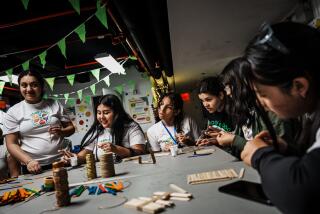A Young Believer : Protest: Teen-age girl is among hunger strikers calling for a UCLA Chicano studies department. She says she is willing to die for the cause.
- Share via
In the back of the sweltering tent that houses her and the other UCLA hunger strikers, Norma Montanez sat quietly, clutching an eagle feather.
As she closed her eyes and sipped some water, a man dressed as an Aztec “spiritual warrior” hovered nearby, watching as she and her fellow protesters struggled through another day without food or even vitamin-enriched water, holding out for a Chicano studies department on the sprawling campus.
The man, who uses the name Pastel, said he has given Montanez the Aztec name Ixtlapapayotl, or Heart of a White Butterfly.
There is much about Montanez that sets her apart from the other hunger strikers, whose nine-day effort to force UCLA Chancellor Charles E. Young to establish a Chicano studies department has won the growing support of civil rights activists and supporters from across the Southland.
Unlike the other people on the hunger fast, who include six UCLA students and a professor, Montanez doesn’t attend or work at UCLA. A shy, self-described sentimentalist, she is a junior at San Fernando High School, fond of playing video games on a Game Boy.
And she is only 16 years old.
Montanez said her decision to fast is anything but a high school lark. It is a cause, she said in an interview, to which she is willing to commit everything.
“I know I’m a minor, but this is my decision,” Montanez said. “I really strongly believe I am doing the right thing. I am willing to die for it.
“In high school, junior high school and elementary school, they don’t teach you anything about us and our people,” she said. “We have been ignorant of our culture for a long time, and I think it is time they teach us who we are, where we come from and what our history is.”
The protesters want a full Chicano studies department, which they say will have the academic weight, breadth and prestige that the existing interdisciplinary Chicano studies program does not.
Montanez said her parents have gathered at the site each day to watch over her and her sister, Cindy, a 19-year-old freshman who came home from class one day and said she was thinking of joining a fast that was being planned.
Montanez wanted to join too--not only to keep her older sister company but to do what she felt was right.
Now weak from hunger, Montanez said half-jokingly that her classmates and teachers at San Fernando High were probably wondering why she had not been in class for more than a week.
Because of her age and her articulate and unhesitant words of conviction, Montanez has become a media darling of sorts, a spokeswoman for the protest movement under way at the university campus.
“When you believe in something, even if you are a child, you will fight for it,” said Pastel, who is not fasting. “It does not matter how old you are.”
Father Juan Santillan has also kept vigil at the hunger strike site, a grassy knoll at Schoenberg Plaza that has taken on the look of a permanent encampment, with tents and banners, information booths and Mexican flags and political posters on every tree and pole.
On Tuesday, Santillan gave Montanez and her fellow protesters a bronze cross and Holy Communion to restore their flagging spirits. He said later that the young girl’s efforts to keep the fast in the face of hunger, weakness and heat has given strength to others on the hunger strike.
“That is the beauty of conviction,” said Santillan of St. Lucy’s Church in the City Terrace section of East Los Angeles. “Because someone is just 16 does not mean they are not aware of what they are doing, the sacrifice they are making.”
At times, there were so many speaking of the protesters’ bravery that the protesters seemed to be overshadowed. One by one, activists and parents rose to a lectern before a massing crowd and spoke of the need to press on with the protest.
At least one protester has fainted from weakness and heart palpitations.
But Edward James Olmos, the actor and political activist, said he is worried not just for Montanez but for all the hunger strikers and the entire campus if the issue is not resolved soon.
“There will be thousands of people here within a few days, sitting here and waiting for an answer,” Olmos said. “And if there is no answer, you will see students and a professor dying here.”
“One of them,” he said, “is only 16 years old.”
During the speeches, few even noticed Montanez being led out of the tent to a nearby outhouse Tuesday, so weak that two men had to hold her up. Later, she smiled and said she wasn’t feeling all that bad, just a little weak from answering all the news media’s questions.
A doctor at the site said it would be several weeks before the protesters began to experience life-threatening injuries from refusing to eat. Some in the crowd noted how Cesar Chavez, who has been an inspiration to Montanez and her fellow protesters, had gone more than a month on water alone.
Cindy Montanez said the support of her sister and her parents has kept her going. “If not for them,” she said, “I don’t know if I would have been able to follow through with this.”
A Chicano studies major, Cindy Montanez said she would not have let her sister join in the hunger strike unless she had promised to stop if her health was in danger. When told Norma had promised to starve herself to death if necessary, her sister said: “She changed her mind without telling me. But I don’t think any of us are going to die. It is going to be a long struggle, but we will all come out OK.”
But that was little comfort to Margarita Montanez, who wrung her hands and worried about the fate of her two daughters, especially her youngest.
“It has been hard,” the mother said. “But I remember the time when my daughters respected my decisions. So now it is time for me to respect theirs.”
Although Margarita Montanez still worries, she prays for a happy ending too, one in which her youngest daughter gets to come back to the campus, but as a student.
“She’s always dreaming of coming here,” the mother said, looking toward the olive drab tent in which her daughter was resting. “That’s why she wants a Chicano studies department, so she can know her heritage.”
More to Read
Sign up for Essential California
The most important California stories and recommendations in your inbox every morning.
You may occasionally receive promotional content from the Los Angeles Times.










